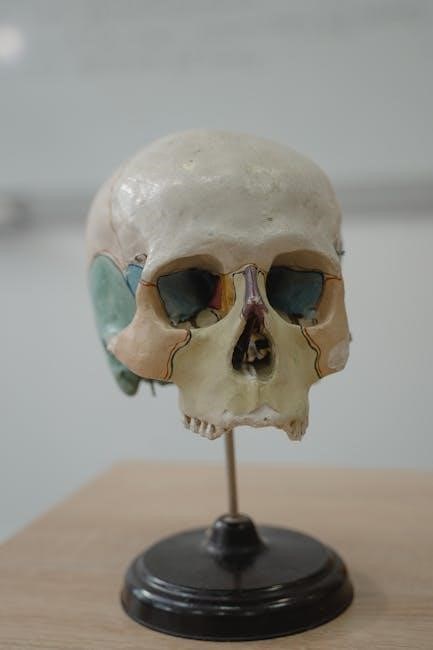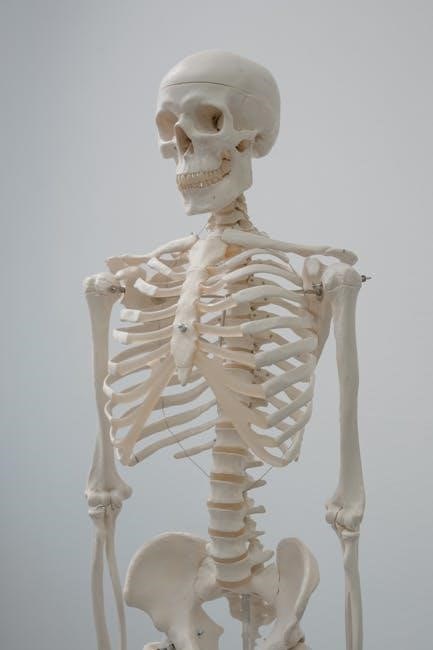Anatomy and physiology are foundational sciences studying the structure and function of the human body. They explore how systems interact to maintain health, essential for medical and healthcare education.

1.1 Definition and Scope of Anatomy and Physiology
Anatomy is the scientific study of the structure and organization of the human body, focusing on the physical arrangement of organs, tissues, and cells. Physiology explores how these structures function, examining the processes that sustain life, such as digestion, circulation, and nerve impulses. Together, they provide a comprehensive understanding of how the body operates as an integrated system. The scope of anatomy and physiology extends from microscopic cellular mechanisms to the macroscopic functions of entire organ systems, offering insights into health, disease, and the human body’s remarkable adaptability. These disciplines are essential for medical education, research, and clinical practice, forming the foundation for diagnosing and treating disorders. Mastery of these subjects is critical for professionals in healthcare, enabling them to apply theoretical knowledge to real-world scenarios effectively.
1.2 Importance of Studying Anatomy and Physiology
Studying anatomy and physiology is crucial for understanding the intricacies of the human body and its functions. These disciplines form the cornerstone of medical and healthcare education, enabling professionals to diagnose and treat disorders effectively. Anatomy provides a structural basis, while physiology explains how systems interact to maintain health. This knowledge is vital for careers in nursing, medicine, physical therapy, and biomedical research. Additionally, it equips individuals with the ability to make informed decisions about personal health and wellness. By grasping these concepts, students can better appreciate the body’s complexity and develop practical skills for clinical practice. The integration of anatomy and physiology fosters a holistic understanding, essential for addressing modern healthcare challenges and advancing medical science. Ultimately, this study empowers individuals to contribute meaningfully to improving human health and quality of life.

Sample Questions and Answers for Anatomy and Physiology Exam
How many bones are in the adult human skeleton?
a) 200
b) 205
c) 210
d) 206
Answer: d) 206
Which muscle is the largest in the human body?
a) Biceps
b) Quadriceps
c) Gluteus maximus
d) Deltoid
Answer: c) Gluteus maximus
What is the longest nerve in the human body?
a) Vagus nerve
b) Sciatic nerve
c) Optic nerve
d) Ulnar nerve
Answer: b) Sciatic nerve
2.1 Multiple Choice Questions (MCQs) on Skeletal and Muscular Systems
These questions assess your understanding of the skeletal and muscular systems, focusing on their structures and functions.
- How many bones are in the adult human skeleton?
a) 200
b) 205
c) 210
d) 206
Answer: d) 206 - Which type of cartilage is found at the joints of long bones?
a) Fibrous
b) Hyaline
c) Elastic
d) Calcified
Answer: b) Hyaline - What is the largest muscle in the human body?
a) Biceps
b) Quadriceps
c) Gluteus maximus
d) Deltoid
Answer: c) Gluteus maximus - Which ligament is known as the “Y-shaped ligament of Bigelow”?
a) Glenoidal labrum
b) Ischiocapsular
c) Iliofemoral ligament
d) Pubocapsular
Answer: c) Iliofemoral ligament
These questions help reinforce key concepts in anatomy and physiology, ensuring a strong foundation for exam preparation.

2;2 Practice Questions on Nervous and Circulatory Systems
These questions focus on the nervous and circulatory systems, testing your knowledge of their structures, functions, and interconnections.
- What is the structural and functional unit of the nervous system?
a) Brain
b) Axon
c) Dendron
d) Neuron
Answer: d) Neuron - Which part of the brain controls breathing and circulation?
a) Cerebrum
b) Cerebellum
c) Medulla oblongata
d) Diencephalon
Answer: c) Medulla oblongata - Which blood vessel carries oxygenated blood to the body?
a) Veins
b) Arteries
c) Capillaries
d) Lymphatic vessels
Answer: b) Arteries - Which system is responsible for transmitting nerve impulses?
a) Circulatory
b) Nervous
c) Muscular
d) Skeletal
Answer: b) Nervous
These questions help you assess your understanding of the nervous and circulatory systems, key areas in anatomy and physiology exams.

Tips for Preparing for Anatomy and Physiology Exams
Effective preparation involves active learning, using diagrams, and spaced repetition. Focus on understanding concepts, not memorization. Practice with past exams and flashcards to build confidence and clarity.
3.1 Effective Study Strategies for Anatomy and Physiology
Mastering anatomy and physiology requires a structured approach. Use detailed diagrams to visualize body systems, label structures, and understand their functions. Flashcards are excellent for memorizing key terms and concepts. Spaced repetition helps reinforce long-term retention. Active learning techniques, such as self-testing and summarizing notes, enhance comprehension. Focus on understanding how systems interact rather than rote memorization. Regular review sessions, including practice quizzes, improve familiarity with exam formats and reduce test anxiety. Incorporate real-life applications to make learning engaging and relevant. Utilize online resources, like interactive models and video tutorials, for a comprehensive grasp of complex topics. Consistency and organization are key to excelling in these subjects.
3.2 How to Approach Different Types of Exam Questions
Approaching exam questions effectively requires tailored strategies for each type. For multiple-choice questions, read carefully, identify key terms, and eliminate incorrect options. True or false questions demand attention to detail, especially with absolute terms. Labeling diagrams necessitates regular practice with structures and their positions. Short answers require concise, accurate responses, so reviewing key definitions is crucial. Essays need detailed explanations, possibly with examples, and organizing thoughts with an outline is beneficial. Practice each question type, use study groups for quizzing, and allocate time wisely. Utilize mnemonic devices, concept maps, past papers, and seek instructor help for challenging areas. Regular practice, systematic review, and effective time management are vital for success.

Common Topics Covered in Anatomy and Physiology Exams
Anatomy and physiology exams often cover the skeletal, muscular, nervous, and circulatory systems, as well as diseases, disorders, and their physiological effects on body functions.
4.1 Structure and Function of the Human Body Systems
Understanding the structure and function of human body systems is crucial for anatomy and physiology exams. The skeletal system, comprising 206 bones, provides support and protection, while the muscular system enables movement through voluntary and involuntary contractions. The nervous system, including the brain, spinal cord, and nerves, controls bodily functions and interprets sensory information. The circulatory system, with its heart, blood, and vessels, transports oxygen and nutrients. Other systems, such as the respiratory, digestive, and endocrine, work interdependently to maintain homeostasis. Exam questions often focus on identifying anatomical structures and explaining physiological processes. Mastery of these topics is essential for success in anatomy and physiology assessments, as they form the foundation of medical and healthcare education.
4.2 Diseases, Disorders, and Their Physiological Implications
Diseases and disorders significantly impact physiological processes, often disrupting normal bodily functions. For instance, conditions like diabetes alter glucose regulation, leading to complications in the endocrine system. Cardiovascular diseases, such as hypertension, affect blood flow and cardiac efficiency. Neurological disorders, including Parkinson’s disease, impair motor control and cognitive processes. Understanding the physiological changes caused by these conditions is vital for developing effective treatments. Exam questions frequently test knowledge of disease mechanisms and their effects on body systems. This includes identifying symptoms, such as Volkmann’s contracture resulting from ischemia, and understanding how structural abnormalities, like vestigial bones, can influence health outcomes. Such knowledge is critical for diagnosing and managing disorders, emphasizing the importance of studying anatomy and physiology in a clinical context.
Exam Format and Structure
Anatomy and physiology exams often include written tests with multiple-choice questions and anatomical diagram labeling. Laboratory practicals may also be required to assess hands-on knowledge and skills.
5.1 Written Exams and Labeling Anatomical Diagrams
Written exams in anatomy and physiology frequently incorporate multiple-choice questions and true/false statements. A key component is labeling anatomical diagrams, which tests students’ ability to identify structures accurately. These exams may also include short-answer questions that require concise explanations of physiological processes or anatomical functions. The format ensures comprehensive understanding, as students must both recognize structures and explain their roles. Diagram labeling often focuses on major systems, such as skeletal, muscular, and nervous systems, ensuring practical application of knowledge. Effective preparation involves practicing with sample diagrams and reviewing system-specific details to enhance recognition and description skills. Understanding the exam structure helps students allocate study time wisely, prioritizing areas commonly tested.
5;2 Laboratory Practicals and Their Significance
Laboratory practicals are a crucial component of anatomy and physiology exams, offering hands-on experience with human structures and physiological processes. These sessions often involve identifying anatomical features in diagrams, models, or specimens, reinforcing theoretical knowledge. Practical exams may include tasks like dissection observations, microscope work, or physiological measurements. They assess a student’s ability to apply knowledge in real-world scenarios, enhancing critical thinking and observational skills. Laboratory work complements written exams by providing a tangible understanding of body systems. Regular practice in labs improves dexterity and familiarity with scientific tools, preparing students for professional environments. Thus, laboratory practicals are essential for developing both theoretical and practical proficiency in anatomy and physiology.
